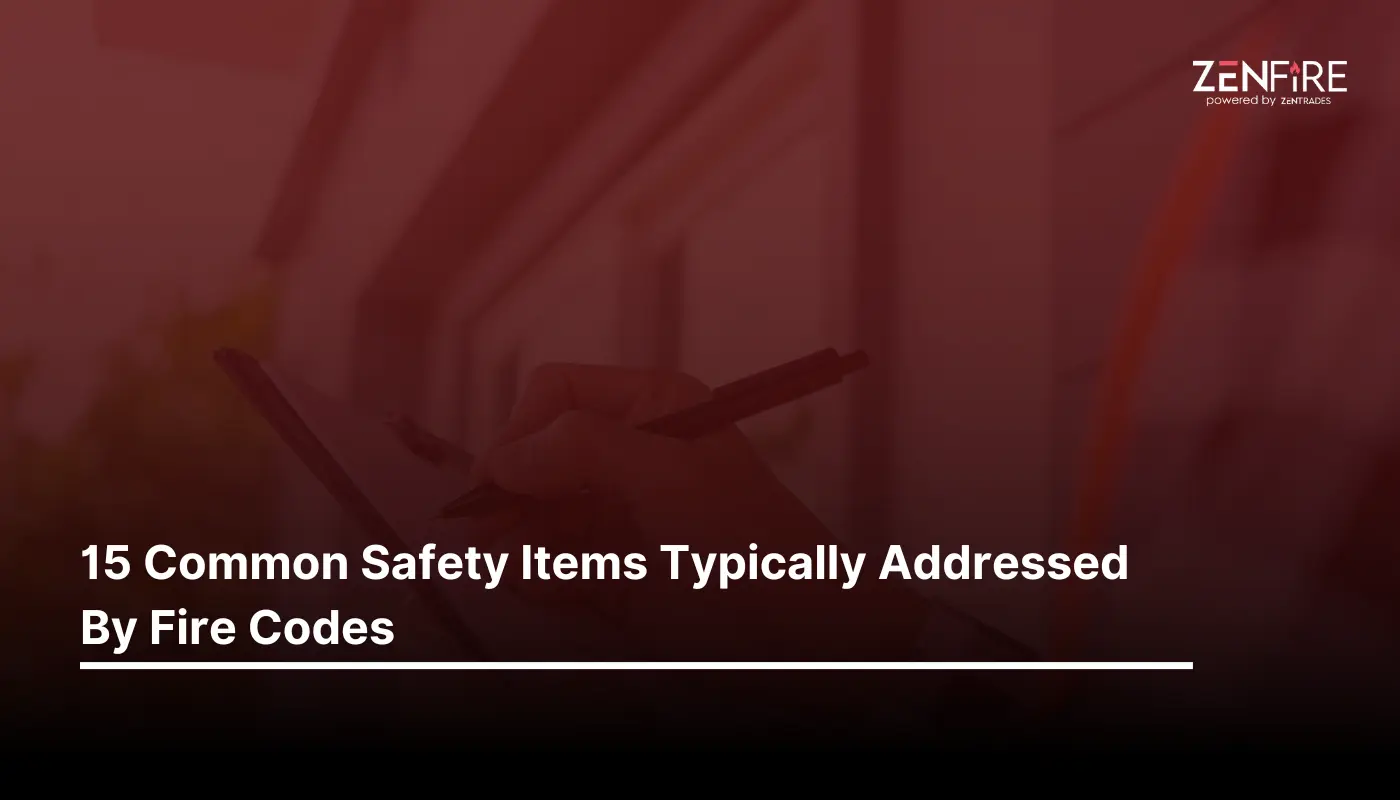15 Common Safety Items Typically Addressed By Fire Codes
- Field Service Management
- 9 Min Read
Fire safety is an imperative measure when securing your property and its occupants from the irreversible dangers of fire. Fire alarm systems and suppression units play a direct role in mitigating fires and protecting individuals. But apart from this, we also have something that helps us prevent a fire situation and minimize the risks via strategic rules and guidelines. Those are what we call fire codes.
Fire codes are the essential and vital preventive framework that helps mitigate risks associated with fire and provide the best possible ways of minimizing such situations. These codes allow us to stay compliant with government and local regulations whilst creating a fire-safe environment for all individuals present.
Here What We Cover
Importance Of Implementing Fire Codes
Fire codes contribute to providing individuals with life safety. These codes cover a wide range of aspects, such as building design, structure and layout, fire protection and notification systems, evacuation planning and procedures, and more. This ensures fire safety, minimizes property damage, and, in turn, saves lives.
These guidelines are essential for a swift emergency response along with effective containment of fire. This is vital as you don’t want the fire to spread to other parts of the building and cause more damage. Not only that, but fire codes are also essential for enabling a safe evacuation procedure. They set down rules and standards for swift egress and customized adjustments for various occupancy types that aid in a quick and uncomplicated evacuation. By providing access to clear pathways to and from the building, these fire codes help keep the chances of injuries down to a significant level that can transpire due to chaos and panic during egress.

Use our free estimate template now
Make winning quotes in minutes—for any industry and any job.
Items Addressed By Fire Codes
Fire codes address and specify rules and regulations for all vital components, procedures, and aspects that directly or indirectly contribute to agile planning. National Fire Protection Association (NFPA) provides an up-to-date list of codes and standards that satisfy the industry’s requirements.
Let’s look at some of the crucial items and facets that fire codes address to enable a seamless safety and prevention system for any establishment.
Fire Exits And Egress
Examples:
- Number of exits
- Aisle size
- Exit door location
- Height and width of the door
- Presence of smoke barriers and fire-safe doors.
Fire Suppression Systems
Examples:
- Installation of hood systems
- Kitchen hood suppression systems
- Suppression agents
- Compatibility of agents concerning potential fire troubles
- Disposal and replacement of agents
Fire Alarm Notification Systems
Examples:
- Visual and audible alarm units
- Alarm placement
- Unit coverage
- Sound volume
- Beep or strobe frequency
- Audibility and intelligibility
Occupancy Limits
Examples:
- Occupancy type
- Count of individuals with disabilities
- Adjustments based on load requirements
- Maximum occupancy calculation
Electrical Safety
Examples:
- Safety from severe electrical hazards
- Equipment selection
- Testing
- Performance
- Precautionary measures
Flammable Materials
Examples:
- Storage of flammable materials
- Dos and don’ts of storage
- Compatibility of materials
Signage And Lighting
Examples:
- Emergency pathway lighting
- Proper signage
- Use of multiple languages
- Adequate illumination of signs
- Photoluminescent or battery-illuminated signs
Fire Evacuation Plans
Examples:
- Emergency response planning
- Notifying occupants
- Egress routes
- Pathway size measurements
- Employee procedures
- Rescue plans
- Accounting individual count after evacuation
Emergency Power Systems
Examples:
- Emergency system load transfer time
- Separation from non-emergency circuits
- Backup power capacity
- Emergency power load
- Installation and environmental conditions
Maintenance Of Fire Protection Systems
Examples:
- Periodic testing of systems
- Battery or agent replacements
- Visual checks
- Annual and monthly inspections
- Testing fire alarm units
- Extinguisher maintenance
- Notification audibility and intelligibility checks
- Vent cleaning
Safety Measures For Disabled Individuals
Examples:
- Visual notification units for visually impaired individuals
- Vibrating alarm units
- Strobe brightness and intensity
- Flash rate and pattern
- Color codes
- Coverage areas
Training And Drills
Examples:
- Employee and staff training on handling safety equipment and systems
- Scheduled at regular intervals
- Meetings for fire policy review and adjustments
- Familiarity with each notification concerning the emergency
- Evacuation procedure training
Smoke Detector Requirements
Examples:
- Placement and coverage
- Number of units to be installed
- Do’s and don’ts of detector installations
- Adequate training on how to respond to alarms
- Interconnection and syncing
Extension Cord Usage
Examples:
- Indirect plugging or usage
- Extended usage
- Indoor unit for outdoor usage
- Usage with portable appliances
Improper Storage
Examples:
- Discarded materials in the fire pump and riser rooms
- Obstruction of gates and pathways by objects
- Inappropriate repository of hazardous materials
- Bundles of combustible substances in one place
Get posts like this in your inbox.
Keep learning how to run a 5-star business with our bi-weekly newsletter.
Conclusion
Fire codes comprise numerous guidelines on how to make your space safer from fire. Complying with these codes is enough to ensure maximum prevention strategies are in place, which can help you attain peace of mind and ensure that individuals are protected even in case of accidental fires. Instilling a sense of confidence in occupants can go a long way to ensure that your property stands out and is labeled as a safe place to inhabit
At ZenFire, we provide a plethora of resources that can help you conduct a preliminary check of your space and building. Our resources include blogs, free tools, and invaluable checklists that can make your process easier to identify and mitigate obvious violation codes.
If you’re a fire safety business owner and looking for a software solution that can help you conduct your inspections in one go, we might have the perfect solution for you! Book a personalized demo with us today, and let us show you the untapped potential of your business.

Explore a better way to grow your business. Book a free demo now!
Get organized, win jobs, and wow customers.
Book A Free Demo with ZenTrades Today!
Related Reading
Why Your Field Software Management Software Needs QuickBooks Integration
ZenTrades Why Your Field Service Management Software Needs QuickBooks Integration Read More Request Demo...
Read MoreZenTrades How To Manage Electrical Service Agreements Like...
Read MoreZenTrades The Best 5 Jobber Alternatives In 2023...
Read More

